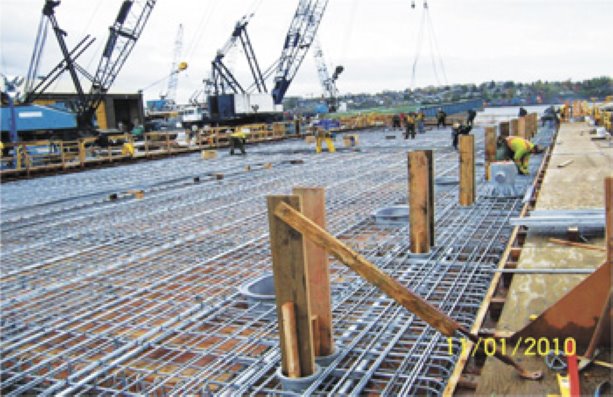Vancouver Pile Driving Ltd. (VPDL) of North Vancouver has won a 2011 Awards of Excellence VRCA Silver Award in the general contractors category on projects up to $15 million.
correspondent
Vancouver Pile Driving Ltd. (VPDL) of North Vancouver has won a 2011 Awards of Excellence VRCA Silver Award in the general contractors category on projects up to $15 million.
VPDL won for the delivery of a new cruise ship terminal to the Nanaimo Port Authority, which is the owner of the project.
The project consisted of the construction of the entire marine works capable of receiving a post-Panamax class cruise ship (a vessel up to 320 metres long, which can be accommodated by the expanding Panama Canal.)
A sub-component of the project was the design-build of a 350 foot by 50 foot floating concrete pontoon, which serves as a mooring structure for the ships to lay against and as a walkway for disembarking passengers.
The cruise ship berth has six fixed mooring / berthing structures (dolphins) that are connected by steel catwalks; a 112-metre long concrete approach trestle from shore; and a fabricated steel access ramp that connects the fixed and floating structures.
“The dedicated cruise berth provides Nanaimo with the infrastructure to become a destination city for cruise ships,” said VPDL project manager Robert Windecker.
“Previously, passengers would have to be shuttled ashore, while ships remained at anchor.”
Windecker said there were five main stages of construction after design and tender.
In order, they were false-work construction, pile driving, construction of the fixed-access concrete trestle, construction of offshore pre-cast components at VPDL’s marine terminal in North Vancouver and on-site installation of pre-fabricated steel work.
Pilings were driven using all marine-based equipment that was towed by scow across the Strait of Georgia from North Vancouver to Nanaimo.
Money and time was saved by using spin fin piles, which consist of a pipe pile equipped with angled plate fins.
The heavy mooring and berthing dolphin caps (85-150 tonnes) were constructed in the VPDL yard and installed by the “Big Johnson” stiff-leg erector.
Windecker said the construction of the concrete trestle, which receives pedestrian traffic from the cruise ships, was on the critical path from Day One.
“The six pre-cast concrete pile caps were constructed in two stages,” he said.
“The first stage was pre-cast to avoid the requirement for a soffit on-site, saving on schedule and budget. Once the first stage was installed on the piles, box girders were installed and the second stage of concrete was poured.”
Windecker said the biggest challenges VPDL faced on the project were not much different from those commonly faced in the industry .
This included scheduling and the availability of skilled tradesmen. The project schedule was intense and driven on two fronts.
“First, the project was partially funded under the Federal Economic Stimulus Package, which had tight funding deadlines,” Windecker explained.
“Second, the arrival of the first visiting cruise ship was already scheduled (May 7, 2011) and there was no moving that date.”
Windecker said VPDL monitored progress continually as the work progressed, and made adjustments to shifts, crews and resources as required.
“Work planning was complicated by the need to build inter-tidal structures through the winter months, because of high daytime tides,” he said
The development and build-up of the marine crews was also a challenge.
“We were lucky to have a great group of highly skilled men on the project, including pile drivers and operating engineers,” he said.
“But, we found it can be an ongoing challenge to locate and hire all of the manpower required to fully man a project, given the specialization of the marine industry and concurrent competing projects, both in-house and in the industry in general.”
The construction time-line was extremely tight.
The project tender closed in May 2010. VPDL was officially awarded the project in June 2010.
Procurement of materials and long lead-time items began immediately.
Site work began in mid-August 2010 and the work was deemed substantially complete in April 2011, in time to receive the first cruise ship. The total cost of the project was $13.65 million.










Recent Comments
comments for this post are closed